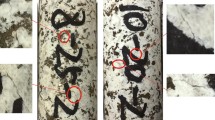Abstract
A sample of Westerly granite was deformed under constant stress conditions: a pore pressure of 5 MPa, a confining pressure of 10 MPa, and an axial load of 170 MPa. Pore volume changes were determined by measuring the volume of pore fluid (0.01M KClaq) injected into the sample. After 6 days of creep, characterized by accelerating volumetric stain, the sample failed along a macroscopic fault. Measurements of complex resistivity over the frequency range 0.001–300 Hz, taken at various times during creep, showed a gradual increase in both conductivity and permittivity. When analysed in terms of standard induced polarization (IP) techniques, the changing complex resistivity resulted in systematic changes in such parameters as percent frequency effect and chargeability. These results suggest that it may be possible to monitor the development of dilatancy in the source region of an impending earthquake through standard IP techniques.
Similar content being viewed by others
References
Arulanandan, K. andMitchell, J. (1968),Low frequency dielectric dispersion of clay-water-electrolyte systems. Clay and Clay Minerals16, 337–351.
Barsukov, O. M. (1970),Relationship between the electrical resistivity of rocks and tectonics processes. Bull. (Izv) Acad. Sci. U.S.S.R., Earth Physics1, 55.
Barsukov, O. M. andSorokin, O. N. (1973),Variations in apparent resistivity of rocks in the seismically active garm region, Bull. (Izv) Acad. Sci. U.S.S.R., Earth Physics10, 685.
Brace, W. F., Orange, A. S. andMadden, T. R. (1965),The effect of pressure on the electrical resistivity of water-saturated crystalline rocks. J. Geophys. Res.70, 5669–5678.
Brace, W. F. andOrange, A. S. (1966),Electrical resistivity changes in saturated rock under stress, Science153, 1525–1526.
Brace, W. F. andOrange, A. S. (1968a),Further studies of the effects of pressure on electrical resistivity of rocks, J. Geophys. Res.73, 5407–5420.
Brace, W. F. andOrange, A. S. (1968b),Electrical resistivity changes in saturated rocks during fracture and frictional sliding. J. Geophys. Res.73, 1433–1445.
Brace, W. F. (1971),Resistivity of saturated crustal rocks to 40 km based upon laboratory measurements in the structure and physical properties of the Earth's crust, Geophys. Monogr. Ser.14, edited by J. G. Heacock, 243–255, AGU, Washington, D.C.
Brace, W. F. (1975),Dilatancy related electrical resistivity changes in rocks. PAGEOPH113, 207–217.
Cole, K. S. andCole, R. H. (1941),Dispersion and adsorption in dielectrics, I. Alternation current characteristics, J. Chem. Phys.9, 341–351.
Dissado, L. A. andHill, R. M. (1984),Anomalous low-frequency dispersion, J. Chem. Soc. Faraday Trans. 280, 291–319.
Fujii, N. andHamano, Y.,Anisotropic changes in resistivity and velocity during rock deformation. InHigh Pressure Research, Applications in Geophysics (ed. Manghnani, M. H., and Akimoto, S-I.) (Academic Press, Inc., New York 1977) pp. 53–63.
Hadley, K. (1976)Comparison of calculated and observed crack densities and seismic velocities of Westerly granite, J. Geophys. Res.81, 3484–3494.
Hanks, T. C. (1974),Constraints on the dilatancy-diffusion model of the earthquake mechanism. J. Geophys. Res.79, 3023–3025.
Jonscher, A. K. (1978)Low-frequency dispersion in carrier-dominated dielectrics. Philos. Mag. B38, 587–601.
Kranz, R. L. (1979),Crack growth and development during creep of Barre granite, Int. J. Rock Mech. Min. Sci.16, 23–35.
Lockhart, N. C. (1980),Electrical properties and the surface characteristics and structure of clays, I. Swelling clays, J. Colloid and Interface Sci.74, 520–529.
Lockner, D. A. andByerlee, J. D. (1985a),Complex resistivity measurements of confined rocks, J. Geophys. Res.90, 7837–7847.
Lockner, D. A. andByerlee, J. D. (1985b),Complex resistivity of fault gouge and its significance for earthquake lights and induced polarization, Geophys. Res. Lett.12, 211–214.
Madden, T. andCantwell, R. (1967),Induced polarization, a review. Min. Geophys.2, 373–400.
Mazzella, A. andMorrison, H. F. (1974),Electrical resistivity variations associated with earthquakes on the San Andreas fault. Science185, 855–857.
Morrison, H. F., Corwin, R. F. andChang, M. (1977),High-accuracy determination of temporal variations of crustal resistivity. Amer. Geophys. Union Monogr. 20, The Earth's Crust.
Morrison, H. F. andFernandes, R. (1986),Temporal variations in the electrical resistivity of the Earth's crust. J. Geophys. Res.,91, 11618–11628.
Olhoeft, G. R.,Nonlinear electrical properties, In Nonlinear Behavior of Molecules, Atoms and Ions in Electric, Magnetic or Electromagnetic Fields (ed. Neel, L.) (Elsevier, Amsterdam 1979a) pp. 395–410.
Olhoeft, G. R. (1979b),Electrical properties, initial reports on the Petrophysics laboratory, U.S. Geol. Surv. Circ.789, 1–25.
Olhoeft, G. R.,Electrical properties of rocks, InPhysical Properties of Rocks and Minerals, chap. 9 (eds. Touloukian, Y. S., Judd, W. R. and Roy, R. F.) (McGraw-Hill, New York 1980).
Olhoeft, G. R. (1985),Low frequency electrical properties, Geophys.50, 2492–2503.
Parkhomenko, E. I. (1982),Electrical resistivity of minerals and rocks at high temperature and pressure. Rev. Geophys. and Space Phys.20, 193–218.
Sadovsky, M. A., Nersesov, I. L., Nigmatullaev, S. K., Latynina, L. A., Lukk, A. A., Semenov, A. N., Simbireva, I. G., andUlomov, V. I. (1972),The processes preceding strong earthquakes in some regions of Middle Asia. Tectonophysics14, 295–307.
Sumner, J. S.,Principles of Induced Polarization for Geophysical Exploration (Elsevier Scientific Publ. Co., New York 1976) p. 277.
Tapponnier, P. andBrace, W. F. (1976),Development of stress-induced microcracks in Westerly granite. Int. J. Rock Mech. Min. Sci.13, 103–112.
Wait, J. R. (Ed.),Overvoltage Research and Geophysical Applications (Pergamon Press 1959).
Author information
Authors and Affiliations
Rights and permissions
About this article
Cite this article
Lockner, D.A., Byerlee, J.D. Changes in complex resistivity during creep in granite. PAGEOPH 124, 659–676 (1986). https://doi.org/10.1007/BF00879603
Received:
Accepted:
Issue Date:
DOI: https://doi.org/10.1007/BF00879603




